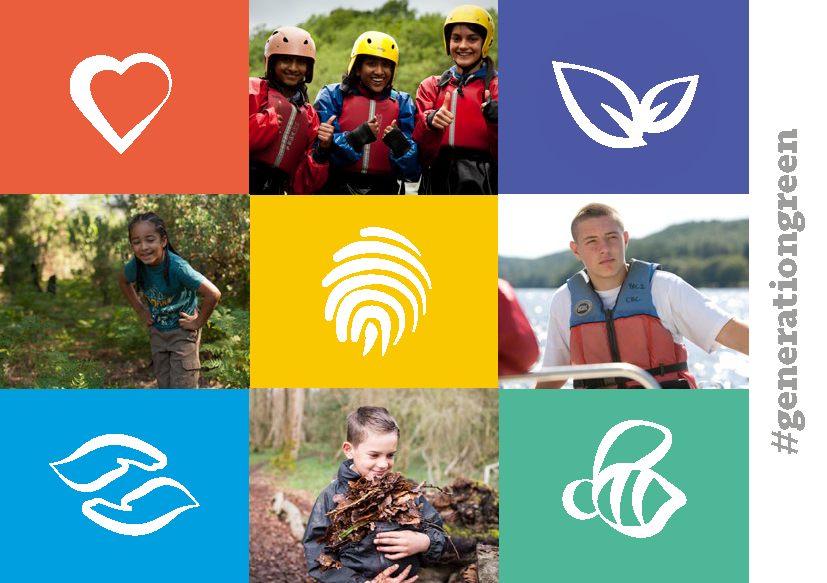Five pathways to nature connectedness
Five pathways to nature connectedness
We are part of nature. As humans, we have a special relationship with the natural world: our actions affect the health of our planet, and nature is really important for our wellbeing too. Connecting with nature can make us feel good, give us the chance to exercise, and let us breathe fresher air.
When we talk about connecting with nature, it’s not just about being outdoors – it’s about how you engage with nature while you’re there. What you do is more important than how long you spend doing it. It's like going to a football game - you're not going just to be in the stadium, it's watching the game and cheering along that makes it so great.
When the University of Derby did some research, they came up with ways that people can build a better relationship with nature – a relationship that helps themselves and the planet. They suggest five ways to be closer to nature and improve wellbeing:
Contact

Use your senses to tune into the sights, smells, sounds, tastes, and textures of nature.
You could:
- Listen to birdsong.
- Smell wild flowers.
- Watch the breeze in the trees.
- Walk barefoot outside.
- Taste blackberries from hedgerows.
When you’re outdoors, encourage everyone to use all their senses – what can they see, hear, smell, feel and taste?
- Do trees or plants have a smell? What do they smell like?
- Are there things that they can touch? Make sure it’s safe to do so and won’t cause any harm.
- What do things feel like? Are they soft, hard, smooth, or prickly? Different things have different textures. Can people feel the difference between bark on a tree, a smooth blade of grass, and a cool pebble?
Get everyone to pause what they’re doing for a minute, and just take in what’s around them. They may want to close their eyes to help them tune into their other senses.
- Can they hear any birds singing?
- Can they feel any breeze on their skin?
You might not be able to taste things, unless you’ve got an adult who knows their stuff with foraging who can identify safe things to eat, like blackberries and wild garlic. Even if you don’t have a foraging expert, you could try to help everyone to tune into this sense in other, safe ways.
- Can they taste the air outdoors, or does it have no taste?
- Does the air feel different to breathe?
Make it accessible:
- If you or anyone in your group can’t use (or has difficulty using) any of their senses, for example, if they have hearing loss or sight loss, think about how you can make sure they’re included and comfortable. How do they experience nature?
- Some people might not be comfortable touching or smelling new or different things, and that’s OK. Everyone can go at their own pace – they don’t have to do anything they’re not comfortable with.
Something sticky
Close your eyes and memorise the feeling and shape of a stick. Can you identify your stick from a collection?
Takes: 10 minutes
Play something stickyMini solo
Can you become one with nature? Take time to explore and connect with the area around you.
Takes: 1 hour
Try mini soloMeet a tree
Can you use your senses to find out which tree you met? Trust you partner and get connected to nature.
Takes: 20 minutes
Try meet a treeRope walk
Be brave and test your senses on this adventurous trail.
Takes: 45 minutes
Use your senses on a rope walkEmotion

Feel joy, wonder, and calm when interacting with the natural world.
You could:
- Find joy in wildlife at play.
- Wonder at a spiders’ web.
- Find calm whilst near water.
Talk about what it feels like being outdoors in nature. Everyone will be different, but it might make them feel joy, calm, wonder, or awe. How does it affect people’s energy levels?
- How did people feel before going outside? How do they feel now? Did they notice a change?
- Ask people to imagine a calm, wonderful, or awe-inspiring place – was it somewhere in nature?
- What does it feel like to watch wildlife? Did people enjoy watching anything in particular? Do some plants and animals bring more joy than others?
Talk about how everyone feels about damage to the environment.
- How do people feel when they see litter or learn about ways humans are damaging the planet?
- What does it feel like to take action to help?
Discovery treasure hunt
Discover nature by heading out on a treasure hunt. How many items will you find?
Takes: 25 minutes
Discover nature on a treasure huntSound fists
Relax and listen to the sounds of nature. Can you recreate what you hear?
Takes: 15 minutes
Try sound fistsOn the flipside
Use your senses to see nature from a different perspective.
Takes: 20 minutes
See nature on the flipsideGratitude scavenger hunt
Tune into your emotions and sensations with this scavenger hunt with a difference!
Takes: 20 minutes
Go on a gratitude scavenger huntBeauty

Use the art and music of nature to inspire creativity and celebrate what nature means to you.
You could:
- Create some wild art.
- Paint an insect’s amazing colours.
- Take a photo of a flower.
- Visit an amazing view.
Encourage everyone to take their time when they’re spotting and identifying nature. Can they notice different colours and shapes? Can they spot any patterns? People could notice the pattern of veins on a leaf or the different colours on an insect, for example.
Photos can be a great way to capture the beauty of nature. The group could take some photos while they’re exploring. They could try to capture something from a new angle, or do some close-up photography that brings out hidden details.
Nature’s paint pallet
Can you find all the different colours in nature? Go on a walk and see what you can see.
Takes: 30 minutes
Discover nature’s paint palletNature's orchestra
Get musical with nature – can you play your favourite tune with items around you?
Takes: 15 minutes
Play with nature's orchestraNatural sculptures
Take a walk in your imagination. Can you recreate objects using natural materials?
Takes: 20 minutes
Make natural sculpturesCamera
Can you take a photograph without a camera or smartphone?
Takes: 30 minutes
Take photographs in natureMeaning

Notice how nature appears in songs and stories, poems, and art, and celebrate the mystery, signs, and cycles of nature.
You could:
- Create a story about a tree.
- Map the journey of a bee.
- Read folk-tales about nature.
- Celebrate the longest day, the first swallow or the falling leaves.
Talk about what nature means to everyone.
- Do they have a favourite place or a favourite view? Does anyone have a favourite memory of time they’ve spent in nature? If people haven’t spent much time in nature before, they may be making their favourite memory right now!
- Think of a famous painting or poem – is it about nature?
Talk about the seasons when you’re doing your activities.
- What season is it now? Look around – what clues does nature give people?
Waggle dancing
Become a buzzing bee and use signals to direct your teammates to the right flower.
Takes: 45 minutes
Try waggle dancingLiving art
Ramble and reflect by using natural materials to create a poster of the animals and plants you see along the way.
Takes: 1 hour
Make living artI wonder why
Have you ever stopped and thought… why? Practice curiosity with this simple activity.
Takes: 30 minutes
Practice curiosityTracking
Create a trail for others to follow using tracking signs and symbols.
Takes: 45 minutes
Compassion

Take action to look after the natural world.
You could:
- Feed the birds.
- Plant some wildflowers.
- Take part in a beach clean.
- Dig a pond.
- Put up a nest box.
A lot of the activities in the Green Champions programme are about how people can care for the natural world and take action to help nature.
- Make sure everyone is involved with your project and understands what they’re doing and why.
- Talk about how a big part of being a Scout is being kind and helpful – this goes for the planet as well as people.
- When you’ve finished the programme, help everyone to think about the difference they’ve made. How they can continue to care for nature?
Heroes hike
Hike across your local area, and spot the issues and challenges it’s facing. Can you take action and help?
Takes: 2 hours
Go on a heroes hikeGuided tours
Where do different plants and animals live? Lead a guided habitat tour and decide what you could do to help improve the area.
Takes: 20 minutes
Lead a guided tourCommitment stones
Experience your local environment and make a commitment to protect it.
Takes: 15 minutes
Create a wildlife reserve
Create a micro wildlife reserve and show it to your friends.
Takes: 30 minutes
